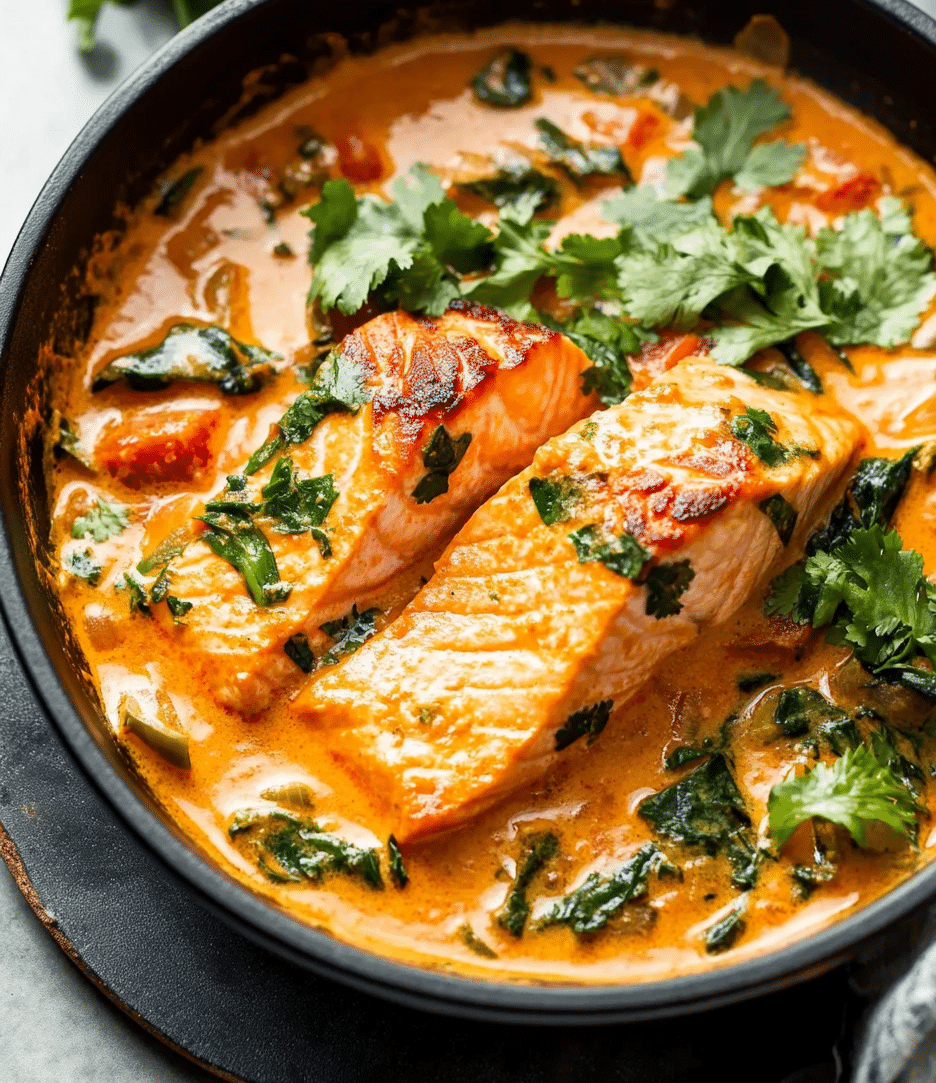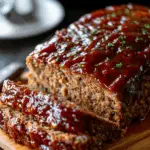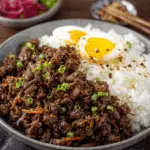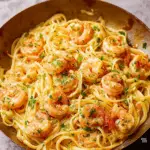This Thai-inspired Salmon Coconut Curry is a rich and flavorful dish featuring pan-seared salmon nestled in a creamy red curry coconut sauce. Bursting with the bold flavors of Thai red curry paste, garlic, and fish sauce, this comforting meal is balanced with tender carrots and broccolini, a splash of lime, and fresh herbs. It’s a quick and satisfying dinner that’s both elegant and easy to make.
Ingredients
-
1 lb fresh salmon, cut into 4 pieces
-
Salt and pepper, to taste
-
1 tablespoon olive oil
-
1 tablespoon butter
-
½ medium onion, chopped
-
2 cloves garlic, minced
-
2 heaping tablespoons Thai red curry paste
-
½ teaspoon fish sauce (optional)
-
1 (13.5 oz) can full-fat coconut milk
-
½ teaspoon brown sugar
-
½ cup matchstick-cut carrots
-
1 heaping cup chopped broccolini
-
1 teaspoon lime juice
-
2 tablespoons torn or chopped fresh basil
-
2 tablespoons chopped fresh cilantro
Directions
-
Cut the salmon into 4 equal pieces. Pat dry with paper towels and season with salt and pepper.
-
In a skillet, heat olive oil and butter over medium-high heat. Once hot, place the salmon skin-side down and cook for 5 minutes. Flip and cook for an additional 2–3 minutes. Remove from skillet and set aside. Optionally, remove the skin.
-
Spoon out some of the oil from the pan, leaving about 1 tablespoon. Add chopped onion and sauté for about 3 minutes until lightly browned. Add garlic and red curry paste; cook for 1 minute.
-
Stir in the fish sauce (if using), coconut milk, brown sugar, carrots, and broccolini. Let the mixture simmer gently for 5 minutes, until vegetables are tender-crisp.
-
Add lime juice and return the salmon to the skillet. Warm through for a few minutes. Adjust salt and pepper to taste.
-
Garnish with fresh basil and cilantro. Serve immediately.
Nutritional Information (per serving)
-
Calories: 458 kcal
-
Carbohydrates: 12 g
-
Protein: 27 g
-
Fat: 35 g
-
Saturated Fat: 22 g
-
Cholesterol: 70 mg
-
Sodium: 176 mg
-
Potassium: 837 mg
-
Fiber: 2 g
-
Sugar: 4 g
-
Vitamin A: 5,392 IU
-
Vitamin C: 59 mg
-
Calcium: 97 mg
-
Iron: 5 mg
Why Salmon is the Perfect Protein for This Curry
Salmon, a fatty fish rich in omega-3 fatty acids, is an ideal pairing for red curry and coconut milk. Its firm, flaky texture stands up well to bold sauces, and its naturally rich flavor doesn’t get overwhelmed by the curry’s intensity. In fact, the fat in salmon complements the coconut milk beautifully, creating a decadent bite that feels indulgent without being heavy.
Unlike white fish that can become lost in strong sauces, salmon holds its own and actually benefits from being surrounded by robust ingredients. The quick searing method used in this recipe ensures the fish retains its moisture and develops a slightly crisp exterior, adding texture to the final dish.
Moreover, salmon is a nutritious choice. It’s packed with protein, essential fatty acids, and B vitamins, making it a heart-healthy ingredient that supports brain function and reduces inflammation. In this recipe, salmon elevates the dish from a casual curry to something that feels elegant and nourishing.
Vegetable Additions and Customization Options
One of the beauties of a curry like this is its flexibility. In this particular recipe, carrots and broccolini are used to add color, crunch, and nutrients. Carrots bring a subtle sweetness and a tender bite, while broccolini offers a slightly bitter contrast that cuts through the richness of the coconut milk.
Other vegetables can easily be substituted or added depending on what you have on hand. Snap peas, bell peppers, baby corn, zucchini, or spinach all work well in this dish. For a more hearty version, you can even throw in sweet potatoes or chickpeas.
The dish is also adaptable to different protein choices. While salmon is the star here, shrimp, chicken, tofu, or even tempeh would also be delicious options. The curry base is versatile and forgiving, making it perfect for experimentation.
Flavor Enhancers: Herbs, Lime, and Fish Sauce
Fresh herbs play a crucial role in finishing Thai-inspired curries. In this recipe, basil and cilantro are used to add a pop of color and brightness. Thai basil, if available, adds a slightly peppery, licorice-like flavor that pairs beautifully with red curry. Cilantro, with its citrusy aroma, adds freshness and cuts through the creaminess of the sauce.
Lime juice is another key ingredient, offering a much-needed acidic lift that brightens the entire dish. A squeeze of lime at the end helps balance the rich coconut milk and savory elements from the fish sauce and curry paste.
Fish sauce, while optional in this recipe, contributes a deep umami undertone. It’s one of those ingredients that, when used sparingly, can elevate the dish without overwhelming it. For a vegetarian version, it can be omitted or replaced with soy sauce or tamari.
Serving Suggestions and Pairings
This salmon coconut curry is best served hot, straight from the skillet, with a side of steamed jasmine rice or fragrant basmati rice to soak up the luscious sauce. For a low-carb option, cauliflower rice works wonderfully. If you’re feeling adventurous, serve it with Thai sticky rice for a more traditional experience.
Adding a side of cucumber salad or a light Thai slaw can provide contrast and crunch, making the meal more balanced. You can also offer some naan or roti to mop up the sauce—while not Thai in origin, they make excellent companions.
For beverages, consider pairing this dish with a chilled glass of Riesling or Gewürztraminer. These slightly sweet white wines balance the spice and complement the richness of the coconut milk. A Thai iced tea or a light lager would also be fitting.
Health Benefits and Nutritional Breakdown
In addition to its incredible flavor, this dish is also a nutritional powerhouse. With around 458 calories per serving, it offers 27 grams of protein, 35 grams of fat (largely healthy fats from the salmon and coconut milk), and only 12 grams of carbohydrates. It’s suitable for low-carb or ketogenic diets and is naturally gluten-free.
The high vitamin A and C content comes from the vegetables, particularly carrots and broccolini, supporting eye health and immune function. The inclusion of fresh herbs like basil and cilantro adds antioxidants, while lime juice provides a boost of vitamin C.
Coconut milk, while high in saturated fat, contains medium-chain triglycerides (MCTs), which are metabolized differently than long-chain fats and can be a quick source of energy. When enjoyed in moderation and as part of a balanced diet, dishes like this can contribute to overall health and well-being.
Cultural Appreciation and Respectful Adaptation
It’s important to acknowledge that while this dish is inspired by Thai cuisine, it is a Western adaptation meant to be accessible to home cooks. Traditional Thai curries often involve pounding fresh ingredients into paste, using specific herbs like kaffir lime leaves and galangal, and balancing sweet, salty, sour, and spicy elements with precision.
This recipe simplifies the process by using store-bought curry paste and ingredients commonly found in most grocery stores. While it may not be entirely authentic, it’s made with appreciation and respect for the flavors and techniques of Thai cooking. For those wanting to dive deeper into Thai cuisine, learning to make your own curry paste or experimenting with authentic ingredients is a worthwhile journey.
Conclusion
Salmon Coconut Curry is a vibrant, versatile, and nutrient-packed meal that showcases the beauty of Thai-inspired cooking. With its rich, creamy sauce, tender vegetables, and seared salmon, it offers a comforting and satisfying experience that feels both exotic and familiar.
It’s a dish that can be made on a busy weeknight yet is impressive enough to serve to guests. Whether you’re new to curries or a seasoned lover of global flavors, this recipe is a delicious reminder of how a few quality ingredients can come together to create something truly special. Try it once, and it might just become a staple in your kitchen.






